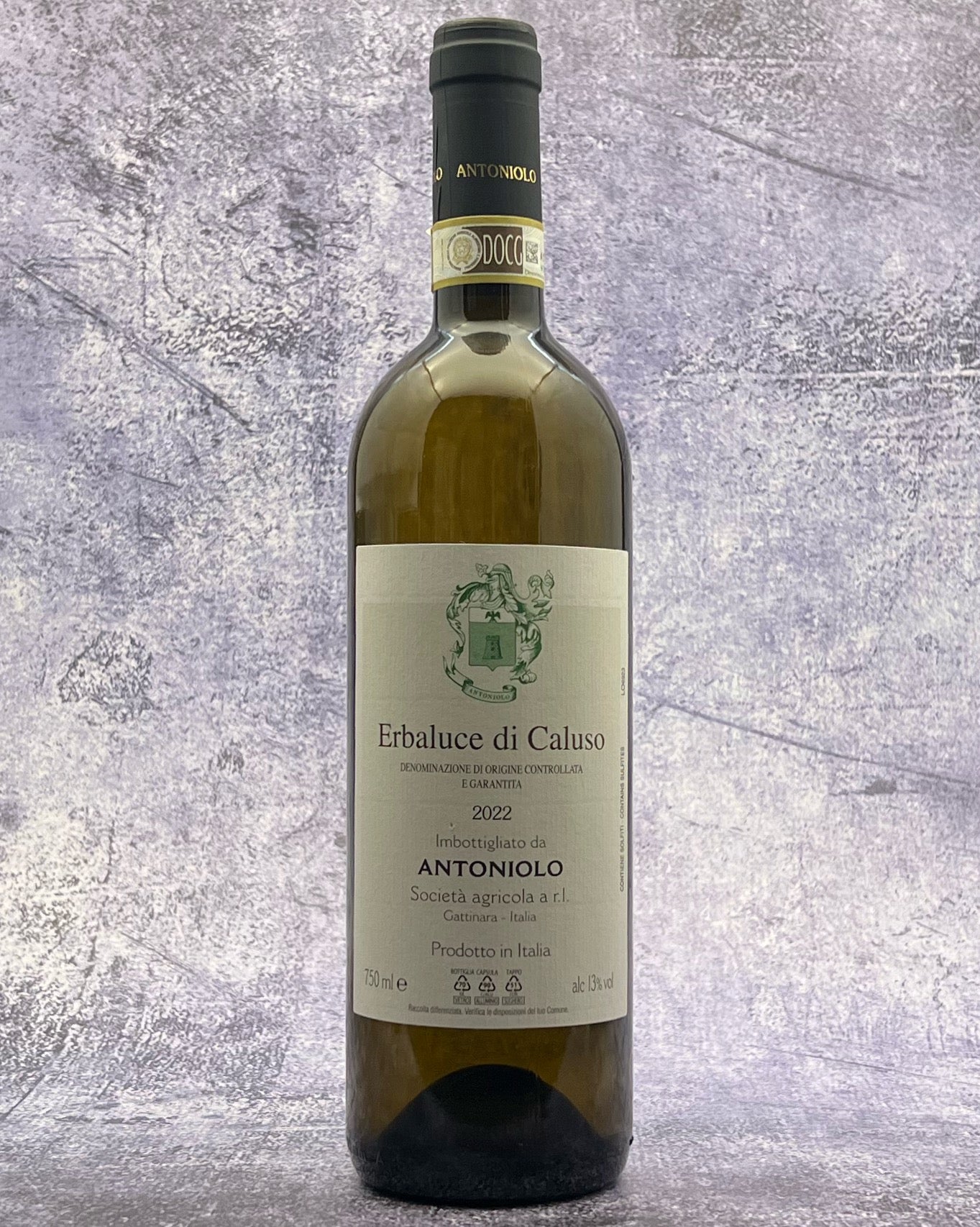Description
From: Alto-Piemonte, Italy
Varietal: Erbaluce
Taste: This ultra vibrant white dances out of the blocks. Lively wild herbs mix with candied orange and a sense of pure, breathy lightness. The wine is energetic, gliding along the palate with chamomile lift and a lovely light layer of apricot fruit that gently settles on the tongue. Great fresh wine for fans of Loire whites and singing, herbal freshness. We have long wanted to get our hands on this tiny volume expression of Erbaluce from the mighty Antoniolo - what a counterpoint to their stately Nebbiolo wines!
Pairing: Erbaluce di Caluso wine is ideal with Canavese (see below) appetizers based on vegetables and beans, but also with river fish and fresh goat cheeses. We’re going to share a non-Canavese pairing from Latin America called Bolitas de Yuca y Queso (Fried Yuca Balls Stuffed With Cheese); it looks amazingly delicious & the recipe can be found right beneath the blurb on the typical foods consumed in Canavese. Happy pairing!
Typical Canavese Cuisine.
In this area, antipasti, which are extremely important at any traditional Piedmontese lunch, begin with cured meats and lardo (seasoned bacon fat). The other antipasti are usually made with eggs or stuffed vegetables, or a combination of sauces made with anchovies. Then there is boiled tongue, and the use of aspic or pickling are also popular for the presentation of vegetables and meats.
One of the main ingredients of Canavese cuisine is cabbage, which we find in “caponet”, rolls made of cabbage stuffed with meat, and in cabbage soup, known as “supa mitonà”, with bread, stock and cheese (joined by sausage and onion in some versions).
Authentic local soups include typical versions made with milk, rice and chestnuts, or stocks made with meat or vegetables, which were once enriched with lots of grated cheese and a few spoons of red wine.
Dishes traditionally served on festive occasions were homemade agnolotti (similar to tiny ravioli) or tajarin (fine pasta ribbons), while rice was eaten frequently, with mushrooms, vegetables or yellow pumpkin.
Meat also used to be reserved for celebrations, with delicious combinations of boiled meats served with red and green sauces, or tasty stews made with game (hare, wild boar) cooked in Carema or Barbera wine, accompanied by polenta, not to mention the Piedmont mixed fry (with sweet and savoury components) or Canavese-style rabbit.
Canavese cuisine is based essentially on two fundamental dishes: bagna caoda, served with raw and/or cooked vegetables, and tofeja (beans with pig’s trotters and pork rind slow cooked in a wood-fuelled oven inside a traditional Castellamonte terracotta pot) which is often served at Carnival. Along with tofeja there are also fresse (meatballs made with offal and raisins, wrapped in pork omentum) and other dishes served traditionally as part of the “Seina del crin” (the Pig’s Dinner), the banquet that traditionally followed the home-production of cured meats and various cuts of pork.
Bolitas de Yuca y Queso (Fried Yuca Balls Stuffed With Cheese)
By Kiera Wright-Ruiz
About. This iconic winery was established in 1940 by Mr. Mario Antoniolo. Mario strongly believed in the potential of the territory and, already at that time, built a small winery with a complete supply chain. Later, Mario was supported by his daughter Rosanna, one of the first female sommeliers in Italy and a master taster.
Currently his grandson Alberto is the wine maker. Even in the generational changes, the philosophy of the family business has remained unchanged: respect for the vineyard and its production, without interfering in any way with the wine obtained. The wines from Antoniolo must be characterized by territorial coherence and elegance and, in some cases, by austerity (their Nebbiolo’s are gorgeous but can be rather austere in their youth - as an example).
Grown in the hills of Alto-Piemonte, Erbaluce is a rare white grape variety that produces crisp wines with notes of melon fruits and wild flowers.
The DOCG. Erbaluce di Caluso was elevated to DOCG in 2010 and is produced just north of the industrial city of Turin and is named after the town of Caluso. The production zone includes 33 municipalities and types is constituted by dry (like this one), semi-sweet and sweet wine.
Erbaluce is an old Piedmontse grape variety that has great challenges ahead of it. It is quite rare, and when you finally meet a bottle, it can easily taste fairly sharp and aggressive. Furthermore, the producers do too little to market it to the wide audience.
The reason why this white wine has a characteristic sharpness is that the grape has a natural high acidity, and if it does not ripen perfectly, which it rarely does in this zone, it offers a rather sharp wine— a fact which should excite lovers of cool-climate white wines from places like Chablis, Sancerre, and Gavi di Gavi.
The dry Erbaluce di Caluso DOCG is a pale, straw-colored wine, with a fine vinous aroma and fresh taste, which is characteristic of the grape. It pairs well with antipasti and fish.
Erbaluce di Caluso DOCG is also available as a Passito type, a late harvested wine where the grapes is harvested in December, which is not successful every year. When it is successful, however, the Erbaluce di Caluso Passito DOCG is more accessible because the grapes of high acidity are perfectly balanced out with sweetness.
The production of Erbaluce di Caluso Passito DOCG is, however, almost microscopic, in some years only about 1,500 bottles (half bottles, mind you) have been produced. The result is, though, an amazing, golden dessert wine of great finesse with lots of aroma and notes of hazelnuts, almonds and grapes. Erbaluce di Caluso Passito DOCG has a minimum mandatory period of aging of 4 years and must have a minimum of 13.5% alcohol content.
A sweeter, dark golden Erbaluce di Caluso Passito Riserva DOCG is also available, with an alcohol content of 17.5% and a mandatory aging period of 48 month before being released on the market. This is a delicate and velvety wine. We wish the passito and passito riserva came to Seattle more! I believe we’ve seen one or two in the area over the last few years; but of course, it’s not available at the moment.
Finally, a fully sparkling, dry Erbaluce di Caluso Spumante DOCG is also available with mandatory 15 months of second fermentation on the bottle (Metodo Classico). Release date on November 1st the fourth year following the harvest. Preferably served with light meals. We’ve found this style to be particularly hard to come by, with prices that exceed current quality.

